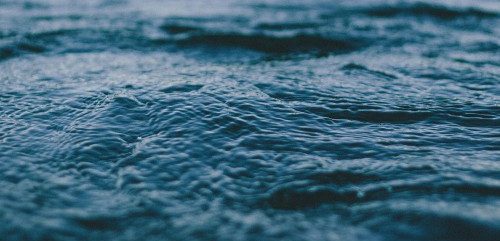Worth knowing about overflows
A case of wastewater spillage into the waters of Øresund that took place because of renovation works on the sewer system in the capital has once again raised a number of relevant questions across the country, including Kolding. Questions like: Why does partially treated wastewater sometimes spill into the water environment, including Kolding Inlet?
Heavy rainfall, more cloudbursts, and generally increasing water volumes are putting sewer systems under ever increasing pressure. This applies to Kolding as well as the rest of Denmark. Some of the 2,200 kilometers of sewer lines below Kolding Municipality are up to 100 years old. Therefore, they are too small compared to the large volumes of water they need to handle today – simply because there was not as much water, neither from above nor from households and businesses, when they were built.
Well, why not just replace those sewer lines with larger ones, one might rightfully ask. The simple answer is that it would cost billions and create chaos if we suddenly started digging up 2,200 km of sewers at once.
In other words, it is simply impossible. However, this does not mean that BlueKolding, collaborating with Kolding Municipality, is not doing anything to address overflows. In fact, we are doing a lot.
You can read a bit more about it in this Q&A which we have created with help from the Environmental Protection Agency. Partly to explain what overflows are, why they happen, and what they actually mean for both swimming water and the aquatic environment. Partly to tell you what you can do to help us minimize them. You can read about it at the very bottom of the page.
You can also read about how small a part of the nutrients and phosphorus released into the aquatic environment that actually comes from wastewater spillages compared to the amounts from agriculture.
Enjoy your read – and thanks for your interest.
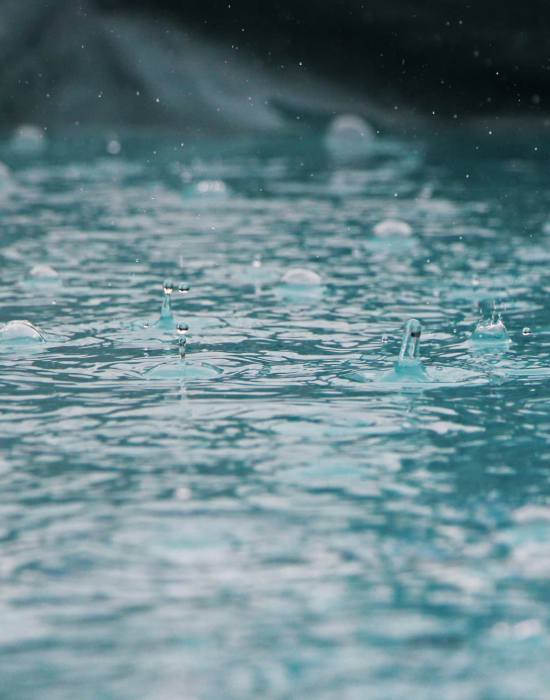
What is wastewater overflow?
Sometimes during heavy rainfall, so much water flows into the sewers and treatment plants that there is not enough capacity in the system. In such situations, a kind of emergency valve, called overflow spillway systems has been created to divert wastewater past the treatment plant and into watercourses or the sea. However, this only happens after mechanical cleaning through a filter, where the largest particles such as toilet paper are removed.
Furthermore, the wastewater is diluted with rainwater, reducing the concentrations of nutrients and bacteria. During heavy rain and significant stress on the sewer system, overflows are necessary to prevent wastewater from backing up into the sewer system. If there were no overflow spillway systems then basements, gardens, roads, and common areas would flood while the water treatment plants would become overloaded.
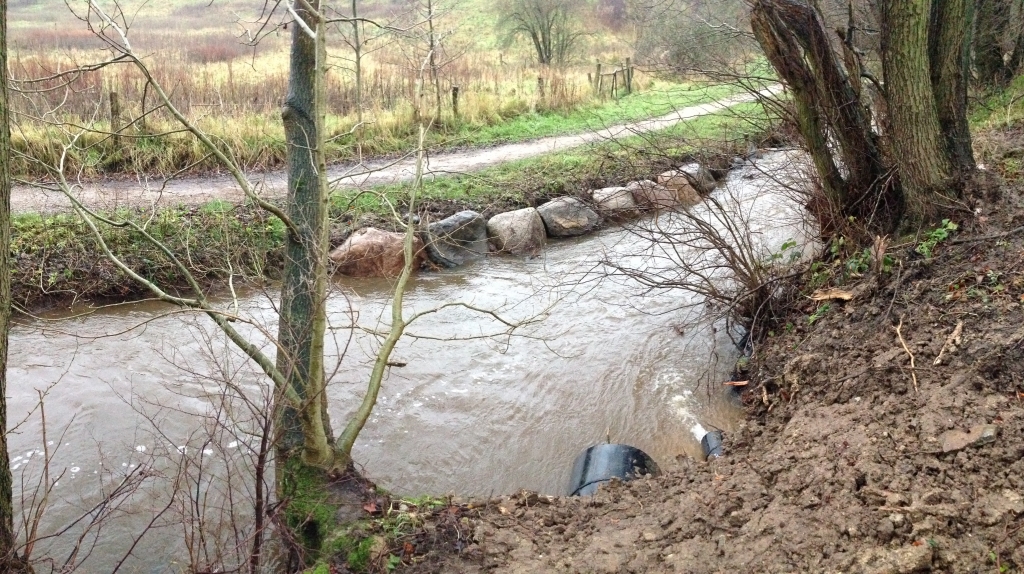
How much wastewater ends up as spillage?
The treatment plants mostly clean the wastewater as planned. A total of 97 % of the discharges in 2018 in Kolding Municipality consisted of fully treated wastewater and rainwater from roofs and roads. Only 3% were spillage with a mixture of rainwater and wastewater.
How many overflow systems are there?
There are currently 99 overflow spillway systems in Kolding Municipality placed along the 2,200 km sewer lines that carry wastewater to BlueKolding’s 5 treatment plants. The number of spillages and the amount of wastewater discharged depends on the amount of rainfall throughout the year, especially the number of heavy rainfalls and cloudbursts. Each year, all municipalities are obligated to report overflow data to the common public point source database “PULS.” Based on this information, the Danish Environmental Agency publishes an annual point source report, summarizing the reported figures. The latest report from 2018 can be found here (Danish).
How is wastewater affecting the environment?
Wastewater contains nutrients that affect mussels, fish, seaweed, and the overall marine environment. These nutrients stimulate algae growth, and subsequently, oxygen depletion can occur when the algae break down. The organic matter content in wastewater settles as sludge on the bottom and can lead to oxygen consumption when it decomposes. The problem is most significant in the summer when algae grow the most due to optimal temperature and light conditions, and where there normally would be too few nutrients for algae to thrive. The Environmental Agency monitors the environmental status in marine water areas. Learn more about the monitoring process here (Danish).
Can overflows be avoided?
The most effective means of avoiding overflow is to ensure that sewers and treatment plants are designed to handle heavy rainfalls, or that rainwater is separated from wastewater through so-called separate sewer systems (see below: What is the difference between combined sewer systems and separate sewer systems?)
Climate change brings more and heavier rain, flowing into sewers that are up to 100 years old and were designed when rainfall was not as intense. In other words, the pipes are too small compared to today’s rainfall amounts. Urban populations are growing, and urban development is making cities denser, increasing the risk of overflows.
To keep pace, BlueKolding continuously expands both sewer lines and treatment plants and implements preventive measures to prevent heavy rainfalls from reaching and burdening the sewer system. Rainwater from roofs can be collected and infiltrated into the ground, or it can be used in, for example, green areas and city gardens. BlueKolding also constructs large basins that can retain rainwater and let it flow into the pipes when there is space.
Moreover, kilometers of sewers are currently being separated to separate rainwater from wastewater. The Environmental Agency’s evaluation of municipal climate adaptation in 2017 showed that projects handling rainwater on the surface are nearly four times cheaper than expanding sewers and other projects handling rainwater underground.
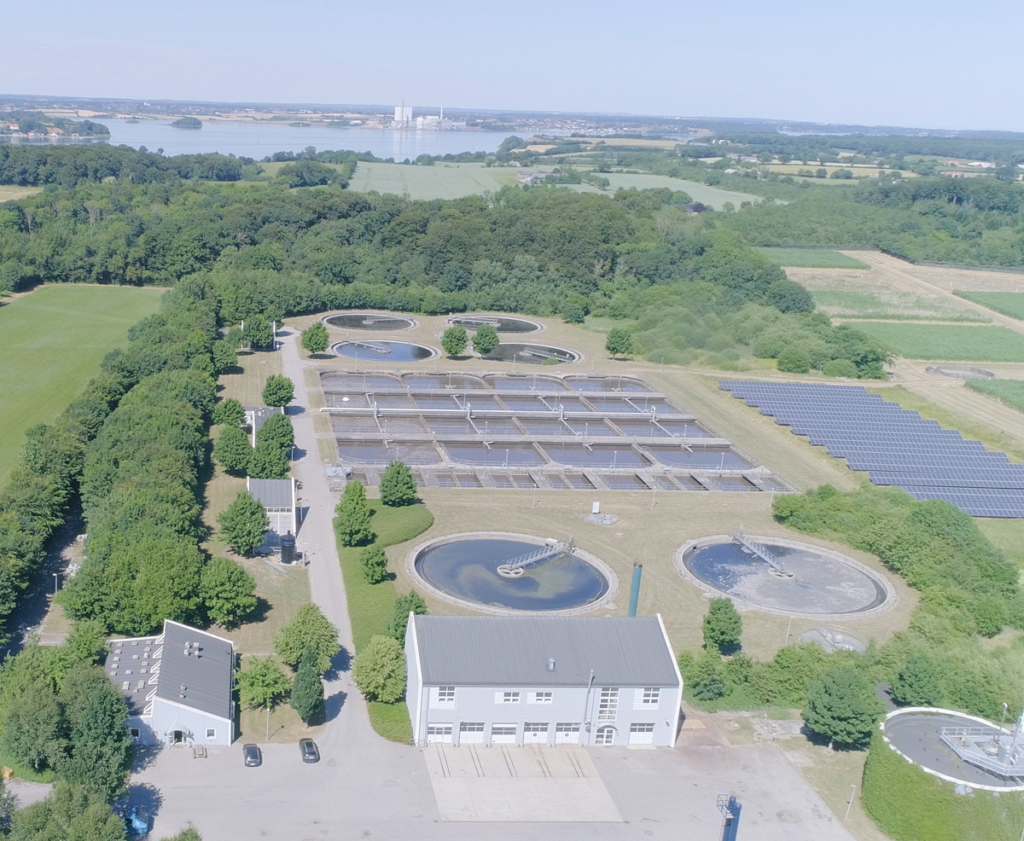
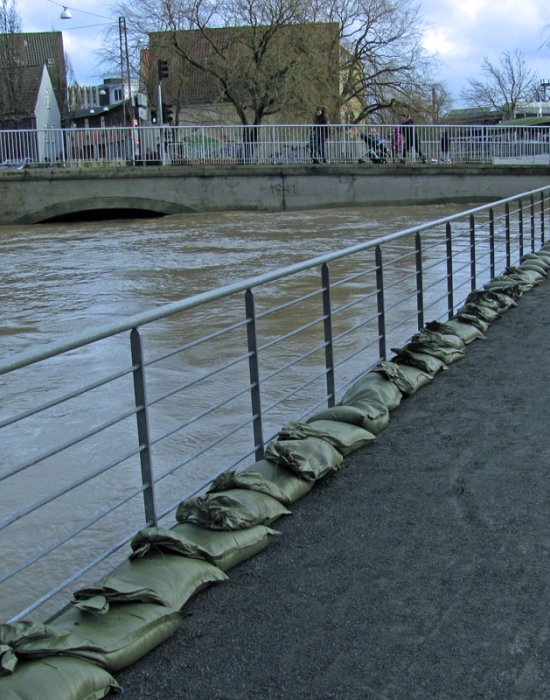
How is sea water affected by overflow?
During overflows, partially treated wastewater diluted with rainwater is discharged. The water contains coliform bacteria, which can cause nausea, discomfort, and upset your stomach. 90 percent of the bacteria will be dead within half an hour after an overflow, but the bacterial content may still be too high. Some studies show that part of the bacteria can survive for several days. Therefore, it can take many days after an overflow before the water water is complately safe again.
The water quality at Kolding’s 14 beaches is generally high and receives the highest quality rating ‘excellent’ on the Environmental Agency’s scale: Poor, satisfactory, good, excellent. See also the Environmental Agency’s page on bathing water quality in Denmark 2019. The water around Kolding also meets the EU’s requirements for bathing quality, and all beaches in Kolding municipality have received the highest EU quality label ‘excellent.’
Kolding Municipality is responsible for monitoring the waters. Up to 10 samples are taken at each beach during the period from May to September. The water samples are analyzed for bacteria such as E. coli and enterococci, which are indicators of, for example, spillage. In addition, Kolding Municipality has invested in an advanced swimming water warning system, which is connected to the ‘Swimming Water’ app and digital boards at local beaches. The warning is a calculation model that assesses the risk of possible spillage after heavy or prolonged rainfall events. If the model indicates a risk of elevated E. coli concentrations at one of the beaches, the beach is marked with a red flag in the app.
In rare cases (if very high bacteria concentrations are measured), it may result in Kolding Municipality advising against swimming. This always happens in consultation with the Danish Patient Safety Authority, which can assess the health aspects of the situation. If the municipality advises against swimming, it will be announced on kolding.dk and directly at the beach with warning signs.
How has spillage developed?
The first Danish water treatment plants were built between 1900-1915. Before that, all wastewater was discharged directly into the watercourses and from there into the sea. The positive development towards better wastewater management began in the mid-1800s when sewer systems started to be constructed in larger cities.
The discharge from treatment plants and other point sources was significantly reduced in the period from 1989 to the mid-1990s, mainly due to the expansion of more and better treatment plants that, with new techniques, could remove more nutrients.
The total discharge of nitrogen, phosphorus, and organic matter from point sources has been reduced by 79 percent, 91 percent, and 90 percent respectively since 1989. There has been a corresponding decrease in nitrogen discharge from agriculture by nearly 50 percent since the 1990s.
Since 2004, the total discharge of nitrogen, phosphorus, and organic matter from point sources has been at virtually the same level. The total discharge of nitrogen, phosphorus, and organic matter from point sources in Denmark from 1989-2018 is shown in the left figure.
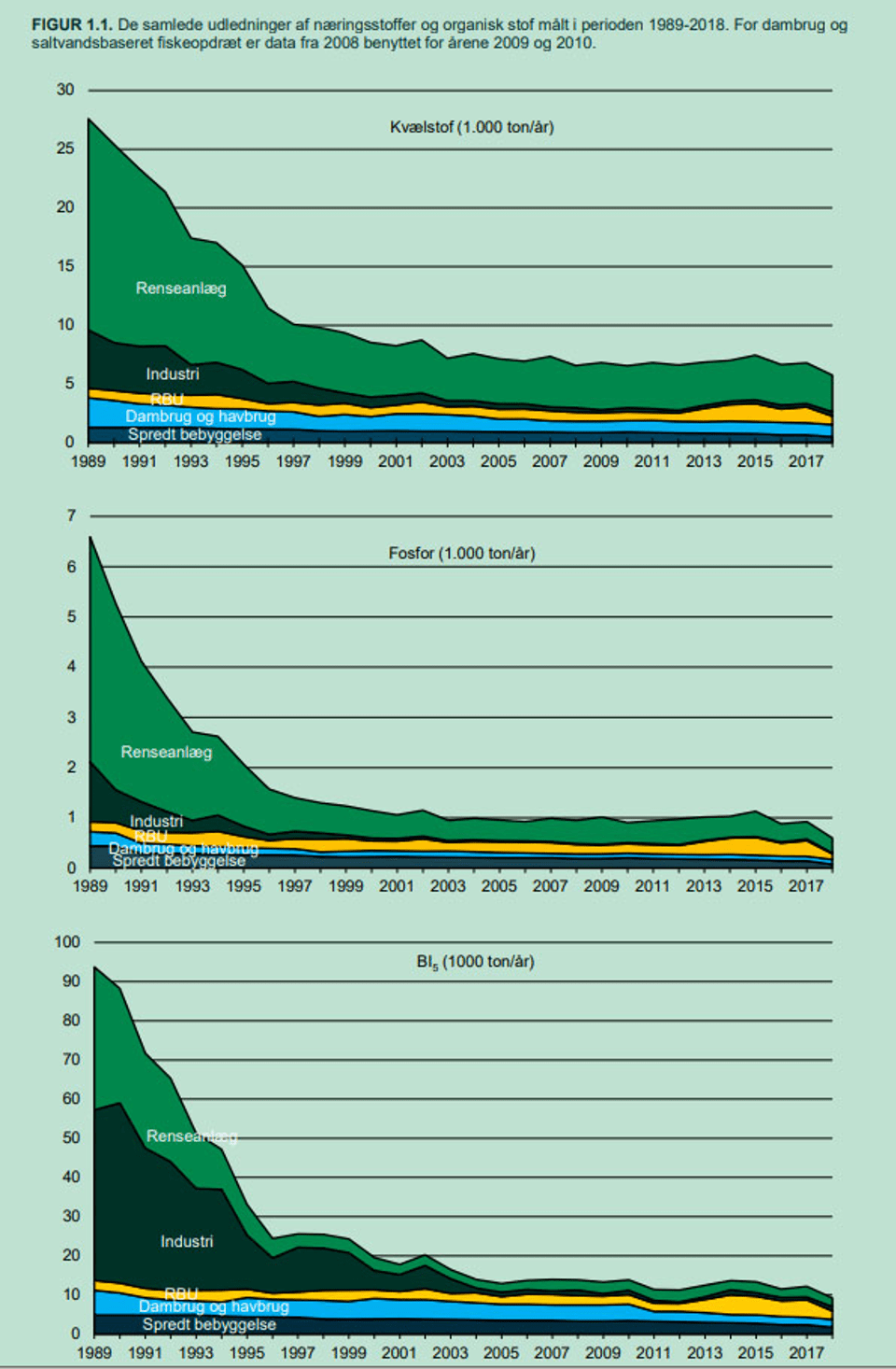
Who discharges the most: treatment plants or agriculture?
Only 1-2 percent of the nitrogen emissions nationwide come from spillages of untreated wastewater. Agriculture accounts for 60-70 percent of nitrogen emissions nationwide. The rest of the nitrogen comes from natural leaching from the soil and from, among other things, the general discharge of treated wastewater from cities, industrial emissions, and scattered settlements. Spillages led to an emission of 715 tons of nitrogen in 2018. That corresponds to about 1.5 percent of all nitrogen emissions.
The wastewater that was treated and subsequently systematically discharged into the environment contained four times as much nitrogen, totaling 3,127 tons of nitrogen. About one-third of the phosphorus that burdens the environment comes from wastewater discharges, including spillages. The figure on the right shows in yellow how the nitrogen emissions have developed nationwide from 1990 to 2018. The green part of each column is the emission of nitrogen from the so-called point sources, especially treatment plants in this context. The yellow part of the column is emissions from so-called diffuse sources, where the majority comes from agriculture.
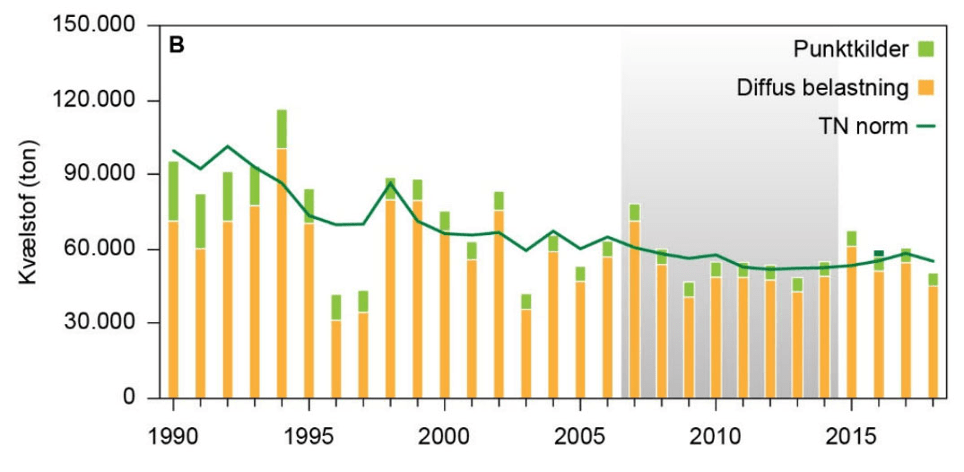
How many nutrients do point sources emit?
The emission of nutrients from treatment plants and sewer systems occurs in the form of treated wastewater, overflows, and roof and surface water. Treatment plants are the largest of the point sources when it comes to nitrogen and phosphorus emissions to the marine environment. About half of the nutrient emissions from point sources come from treatment plants.
When there are still small amounts of nutrients in the wastewater even after treatment, it is because the water is not purified 100 %. It would be disproportionately expensive and time-consuming relative to the environmental benefit, especially considering that about 90 percent of the nitrogen comes from sources other than treatment plants and overflows. In fact, only 1-2 percent of the nationwide nitrogen emissions come from overflows of partially treated wastewater. Agriculture accounts for 60-70.
How uncertain are the calculations?
The calculations are fairly uncertain, but efforts are made to find methods to increase the accuracy of the numbers, which can be up to 150-200 percent in calculations of the annual amount of nutrients emitted from individual discharges. Both under- and overestimation can occur in individual spillages. The uncertainty does not change the fact that the total overflow emissions nationwide are estimated to be a few percent of the total nitrogen emissions.
BlueKolding is working on the BlueOverview project, which aims to ensure more accurate measurement of both the quantities and contents of environmentally harmful substances in the spillages from the 99 overflow spillway systems in Kolding Municipality. We expect to be able to perform complete and accurate measurements during 2023.
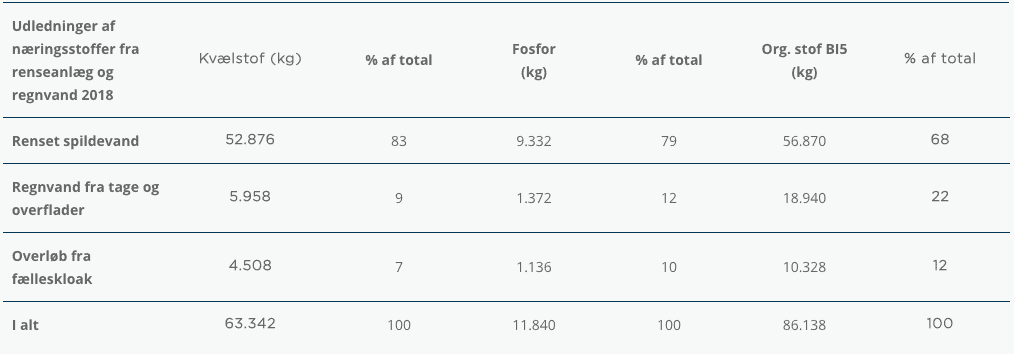
What is the difference between combined sewerage and separate sewerage?
In Denmark, combined sewerage has been in use since ancient times, and in Kolding, approximately 38 % of the sewer system is still combined. In combined sewerage areas, rainwater from roofs and roads is mixed in the sewers with household wastewater. All combined sewers have built-in overflow structures where diluted wastewater can discharge when it rains heavily. In about 40 % of the combined sewerage systems in Kolding, the overflow structures are equipped with basins that collect a portion of the diluted wastewater and direct it to the treatment plant when the rain stops. The basins are established where the water volumes are greatest, so the actual capacity is over 50 %.
Additionally, BlueKolding, through an advanced IT control system, can use the main sewer system in Kolding City as a large basin by automatically directing the water to parts of the system where there is space for it. A more modern alternative to combined sewerage is called separate sewerage. Here, wastewater flows in one pipe, while rainwater flows in another. Rainwater from separate sewerage areas is not contaminated with household wastewater and is usually directed directly to streams and lakes, possibly after treatment in basins. 62 % of the wastewater system in Kolding is separate sewerage, and the number is steadily increasing with more projects.
Who grants permission for wastewater discharge?
In Kolding Municipality, it is the Environmental Department under the City and Development Administration that grants BlueKolding permission to discharge wastewater, including overflows. The municipality sets a limit for how much each wastewater facility is allowed to discharge each year in the form of a wastewater discharge permit. There must be discharge permits for all overflow structures, and all overflows must be included in the municipality’s wastewater plan with information, including calculated overflow quantities. Discharge permits must be granted with consideration for the aquatic environment. A discharge permit may not be granted if it hinders the fulfillment of environmental goals for a water area.
Fulfillment can be ensured by setting various conditions in the discharge permit. Municipalities are obligated to annually report figures for the discharges that occur in a joint public database – PULS. In the same database, municipalities must enter the conditions they have specified in the discharge permits issued. Based on the reported data, the Danish Environmental Protection Agency supervises that the discharges from wastewater companies, including overflow systems, do not exceed the permits granted and reported in PULS by the municipalities.
What is done about overflows in water planning?
Kolding Municipality, in collaboration with BlueKolding, is working to reduce wastewater overflows. To reduce overflows from combined sewerage areas, it is necessary to separate rainwater and wastewater so that they run in separate pipes. Alternatively, managing the rainwater from combined sewerage areas in large underground storage basins helps reduce spillages to the environment and prevents wastewater from backing up into sewer pipes and infiltrating basements and open areas. Thus, separating the sewers contributes both to climate adaptation of the wastewater system and to reducing spillages with partially treated wastewater.
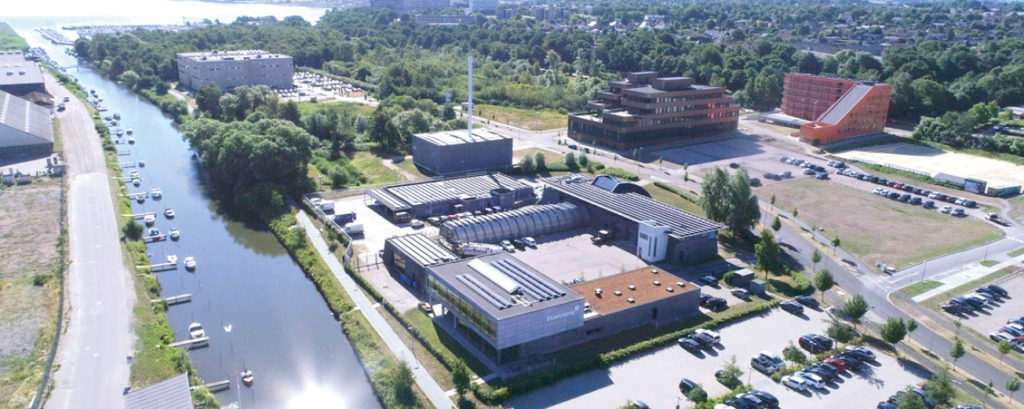
BlueKolding is already working on reducing spillages in connection with the renovation of combined sewerage areas. For example, Rebæk is undergoing separate sewerage to avoid overflows of partially treated wastewater into the fjord at Rebæk Strand. In 2016, a large underground basin was established at Riberdyb, also to reduce wastewater spillages from the combined sewer system, which has a direct connection to the fjord. The mentioned measures are projects directly affecting the swimming water quality in the fjord, and the number of spillages with partially treated wastewater is decreasing for each implemented project.
Furthermore, the wastewater transport system from Kolding city to the central treatment plant in Agtrup has been supplemented with an additional pipeline in 2020. This increases the supply security for wastewater in the city center and significantly increases the capacity for transporting rain- and wastewater. As a result, there will be considerably fewer overflows of untreated wastewater into the bay, which improves the water quality.
In addition, the outfall pipe from the Kolding Central Treatment Plant to Lillebælt was supplemented with an additional pipeline in 2019, incorporating a turbine system. The extra pipeline significantly increases supply security in case of a potential break in the existing outfall pipe.
Who is responsible – and what can you do?
It is BlueKolding’s responsibility to maintain the more than 2,200 km of combined sewer pipes running under Kolding Municipality. It is the individual property owner’s responsibility to maintain the sewer on their own property. In other words, there is a shared responsibility to ensure that the sewer system functions optimally in its current state. Besides maintaining the relatively small part of the sewer system that you have direct responsibility for on your own property, you can also help take care of the sewers we collectively own. BlueKolding is owned by Kolding Municipality, and ultimately by you, so we share an interest in taking care of the sewers.
So, what can you do specifically? In reality, the most effective actions are also quite simple: Ensure that only what belongs in the sewer from your household goes into it. Most importantly, only items you have eaten or drunk (and, of course, toilet paper) should go into the toilet. No cotton swabs, no disposable wipes, no condoms, or anything else you might be tempted to flush. Just the essentials, and toilet paper – that’s it. Anything else can get stuck in the pumps that need to lead wastewater to the treatment plant. If the pumps fail, and the water cannot flow through the pipes, it contributes to overflows. It gets even worse if you pour grease from the frying pan and other cooking residues down the kitchen sink. You can probably imagine what happens when the fat runs down the sewer, cools down, solidifies, and then mixes with everything that should not have been in the toilet… Apart from damaging the pumps, it also creates blockages in the sewer pipes, preventing wastewater from flowing through, leading to overflows.
So: Only what comes out of you (+ toilet paper) in the toilet. And: No fat in the kitchen sink. By doing just that, you have already helped us (and thus yourself) a lot. It will not solve all overflow problems, but it will make a big difference. The side benefit is that we will save millions of kroner on repairing and replacing the pumps that get damaged by everything that should not have been in the sewer. The money we save can then be used for additional efforts to further reduce overflows.
Another thing you can do is to utilize the rainwater that falls on your property instead of letting it go into the sewer. It is not only good because it provides more space in the sewer system but also for your wallet because you can get a part of your connection fee refunded.
